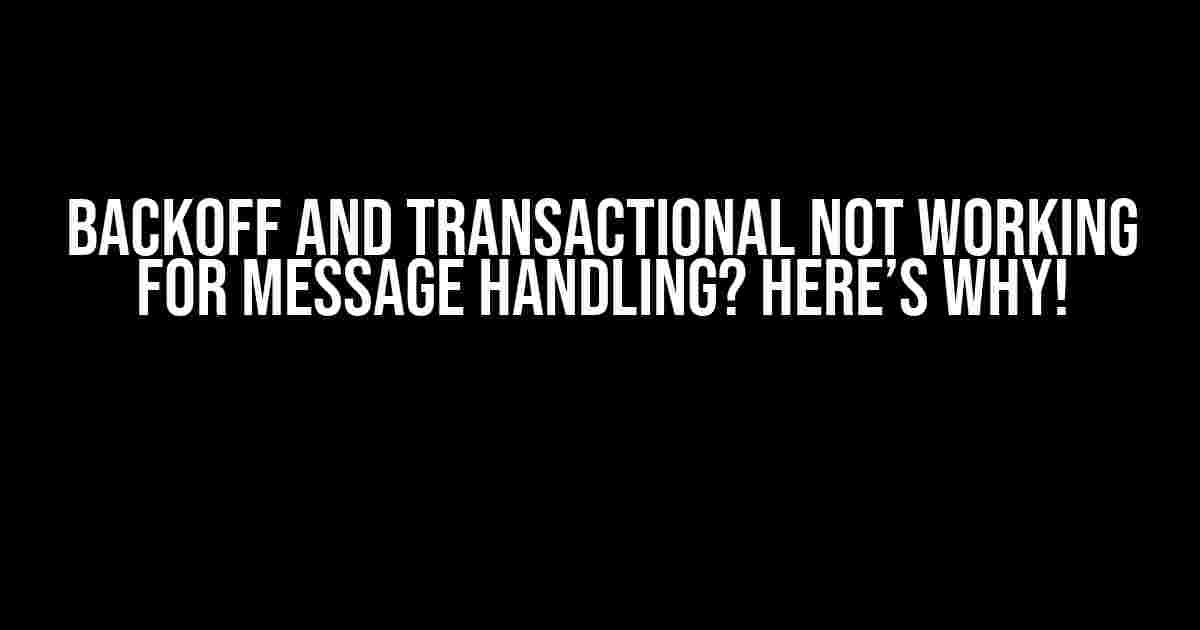Are you tired of banging your head against the wall, wondering why your BackOff and transactional messages aren’t working as expected? Don’t worry, you’re not alone! In this article, we’ll dive into the mysterious world of messaging systems and uncover the secrets behind this frustrating issue.
The Problem: BackOff and Transactional Not Working for Message Handling
You’ve set up your message handler to use BackOff and transactional mechanisms to ensure reliable and fault-tolerant message processing. However, despite your best efforts, you’ve noticed that:
- Messages are not being retried upon failure
- Transactional messages are not rolling back when an exception occurs
- Your message handler is not properly handling failures and exceptions
It’s as if your BackOff and transactional configurations are being ignored, leaving you feeling frustrated and helpless. But fear not, dear reader, for we’re about to uncover the root cause of this issue and provide a step-by-step solution to get your messaging system back on track.
The Culprit: Misconfigured Listener Setup
The root cause of this problem lies not in your message handling code, but rather in the way you’ve set up your listener. Yes, you read that right – the listener setup is the key to unlocking the mystery of non-working BackOff and transactional mechanisms.
Listener Setup 101: A Quick Refresher
Before we dive into the solution, let’s take a step back and review the basics of listener setup:
<bean id="listener" class="org.springframework.jms.listener.DefaultMessageListenerContainer">
<property name="connectionFactory" ref="connectionFactory"/>
<property name="destination" ref="destination"/>
<property name="messageListener" ref="messageListener"/>
</bean>
In the above example, we’ve defined a listener container that connects to a connection factory, listens to a specific destination, and uses a message listener to process incoming messages. Simple enough, right?
The Fix: Configuring BackOff and Transactional for Listener Setup
Now that we’ve established the listener setup as the root cause of the problem, let’s explore how to configure BackOff and transactional mechanisms specifically for the listener:
Enabling BackOff for Listener Setup
To enable BackOff for your listener, you’ll need to add the following configuration:
<bean id="listener" class="org.springframework.jms.listener.DefaultMessageListenerContainer">
<property name="connectionFactory" ref="connectionFactory"/>
<property name="destination" ref="destination"/>
<property name="messageListener" ref="messageListener"/>
<property name="backOff">
<bean class="org.springframework.retry.backoff.ExponentialBackOffPolicy">
<property name="initialInterval" value="500"/>
<property name="maxInterval" value="10000"/>
<property name="multiplier" value="2"/>
</bean>
</property>
</bean>
In this example, we’ve added an `ExponentialBackOffPolicy` to the listener, specifying an initial interval of 500ms, a maximum interval of 10 seconds, and a multiplier of 2. This means that upon failure, the listener will wait 500ms before retrying, then 1 second, then 2 seconds, and so on, until it reaches the maximum interval.
Enabling Transactional for Listener Setup
To enable transactional behavior for your listener, you’ll need to add the following configuration:
<bean id="listener" class="org.springframework.jms.listener.DefaultMessageListenerContainer">
<property name="connectionFactory" ref="connectionFactory"/>
<property name="destination" ref="destination"/>
<property name="messageListener" ref="messageListener"/>
<property name="transactionManager" ref="transactionManager"/>
<property name="sessionTransacted" value="true"/>
</bean>
In this example, we’ve added a `transactionManager` reference and set `sessionTransacted` to `true`. This enables transactional behavior for the listener, ensuring that messages are rolled back upon failure.
Putting it All Together: A Working Example
Let’s create a working example that combines both BackOff and transactional mechanisms for our listener setup:
<bean id="listener" class="org.springframework.jms.listener.DefaultMessageListenerContainer">
<property name="connectionFactory" ref="connectionFactory"/>
<property name="destination" ref="destination"/>
<property name="messageListener" ref="messageListener"/>
<property name="backOff">
<bean class="org.springframework.retry.backoff.ExponentialBackOffPolicy">
<property name="initialInterval" value="500"/>
<property name="maxInterval" value="10000"/>
<property name="multiplier" value="2"/>
</bean>
</property>
<property name="transactionManager" ref="transactionManager"/>
<property name="sessionTransacted" value="true"/>
</bean>
In this example, we’ve combined both BackOff and transactional configurations to create a robust listener setup that can handle failures and exceptions with ease.
Conclusion
In this article, we’ve explored the mysterious world of messaging systems and uncovered the secrets behind non-working BackOff and transactional mechanisms. By configuring these mechanisms specifically for the listener setup, you can ensure reliable and fault-tolerant message processing.
Remember, a well-configured listener setup is the key to unlocking the full potential of your messaging system. So, go ahead and give your listener the love it deserves – your messages (and your sanity) will thank you!
| Configuration | Description |
|---|---|
| BackOff | Enables retry mechanism for failed messages |
| Transactional | Enables transactional behavior for messages |
| Listener Setup | Combines BackOff and transactional configurations for reliable message processing |
By following the guidelines and examples provided in this article, you’ll be well on your way to creating a robust and reliable messaging system that can handle failures and exceptions with ease. Happy coding!
Frequently Asked Question
Got stuck with BackOff and transactional not working for message handling only for listener setup?
Why does BackOff not work for message handling but only for listener setup?
BackOff is a mechanism to delay the retry of a failed message, and it’s usually configured at the listener level. However, when it comes to message handling, it’s a different story. The reason it’s not working for message handling is that the BackOff mechanism is not designed to handle failures during message processing. Instead, it’s meant to handle failures during message reception, like connection issues or timeouts.
How does transactional message handling affect BackOff?
When you use transactional message handling, the message is not acknowledged until the transaction is committed. If the transaction fails, the message is rolled back, and the listener will retry the message. In this case, the BackOff mechanism is not triggered, as the failure is not considered a message reception failure, but rather a message processing failure.
Can I customize the retry mechanism for message handling?
Yes, you can customize the retry mechanism for message handling by using a retry template. A retry template allows you to define a custom retry policy, including the number of retries, the delay between retries, and the maximum number of attempts. This way, you can tailor the retry mechanism to your specific use case.
What are the implications of using a custom retry mechanism for message handling?
When you use a custom retry mechanism for message handling, you need to consider the implications on your system’s performance and reliability. For example, if you set a high number of retries, it may lead to resource exhaustion or message duplication. On the other hand, if you set a low number of retries, you may lose messages. It’s essential to carefully evaluate the trade-offs and test your custom retry mechanism thoroughly.
How can I troubleshoot issues with BackOff and transactional message handling?
To troubleshoot issues with BackOff and transactional message handling, start by enabling debug logging to get more insight into the message flow and retries. You can also use tools like message brokers or queues to visualize the message flow and identify bottlenecks. Additionally, verify that your retry mechanism is correctly configured and that your system can handle the expected load.


